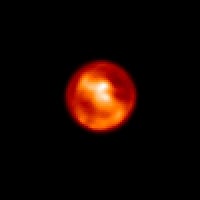For all its similarities to Earth-clouds that pour rain — albeit liquid methane not liquid water — onto the surface producing lakes and rivers, vast dune fields in desert-like regions, plus a smoggy orange atmosphere, Saturn’s largest moon, Titan, is generally “a very bland place,” according to Mike Brown of the California Institute of Technology (Caltech).
“We can watch for years and see almost nothing happen,” said Brown. “This is bad news for people trying to understand Titan’s meteorological cycle. Not only do things happen infrequently, but we tend to miss them when they do happen because nobody wants to waste time on big telescopes.”
However, just because weather occurs infrequently, it doesn’t mean it never occurs, nor does it mean that astronomers can’t catch it in the act.
In April 2008, that’s just what Emily Schaller, now at the University of Arizona, and her colleagues accomplished when they observed a large system of storm clouds appear in the apparently dry mid-latitudes and spread in a southeastward direction across the moon. Eventually, the storm generated a number of bright but transient clouds over Titan’s tropical latitudes, a region where clouds had never been seen and where it was thought they were extremely unlikely to form.
“A couple of years ago, we set up a highly efficient system on a smaller telescope to figure out when to use the biggest telescopes,” Brown said. The first telescope, NASA’s Infrared Telescope Facility, on Mauna Kea, Hawaii, takes a spectrum of Titan almost every single night. “From that we can’t tell much, but we can say ‘no clouds,’ ‘a few clouds,’ or, if we get lucky, ‘monster clouds,'” he said.
“The period during which I was collecting data for my thesis corresponded entirely to an extended period of essentially no clouds, so we never really got to show the full power of the combined telescopes,” Schaller said. “But then, after finishing my thesis, I walked back across campus to my office to look at the data from the previous night to find that Titan suddenly had the biggest clouds ever.”
The day after the telescope’s big find, Schaller, Brown, and Roe began tracking the clouds with the large Gemini telescope on Mauna Kea and watched this system evolve for a month. “And what a cool show it was,” Brown said.
“The first cloud was seen near the tropics and was caused by a still-mysterious process, but it behaved almost like an explosion in the atmosphere, setting off waves that traveled around the planet, triggering their own clouds,” Brown said. “Within days a huge cloud system had covered the south pole, and sporadic clouds were seen all the way up to the equator.”
Schneider, an expert on atmospheric circulations, was instrumental in helping to sort out the complicated chain of events that followed the initial outburst of cloud activity.
“The month-long event has many important implications for understanding the hydrological cycle on Titan,” said Brown, “but one of the reasons I am most excited about it is that it shows clouds near the equator — where the European Space Agency’s Huygens probe landed — for the first time. For a while now, people have speculated that the equatorial regions are simply too dry to ever have significant clouds.”
And yet, the images snapped by the Huygens probe in January 2005 revealed small-scale channels and streams that looked just like features created by fluids — by water here on Earth and probably by liquid methane on Titan.
Experts had speculated for years on how there could be streams and channels in a region with no rain. The new results suggest those speculations may prove unnecessary. “No one considered how storms in one location can trigger them in many other locations,” said Brown.










